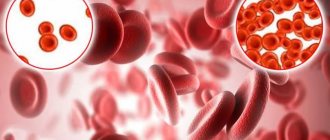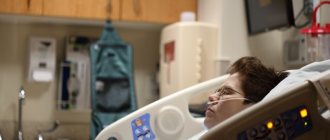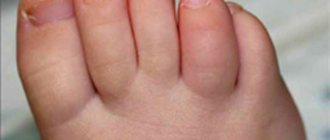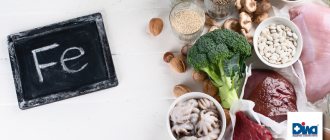Treatment of B12 deficiency anemia in the elderly: regimen and medications
Long-term use of vitamins is provided - initially daily, then in a reduced dosage.
The regimen for taking medications is determined individually by a specialist. The doctor prescribes a treatment regimen for an elderly person. If the patient is unable to take the necessary medications on time, control of the drug treatment regimen is undertaken by:
- in the case of home treatment - relatives or spouses;
- in the hospital - junior medical staff;
- in a boarding house or care home - nurses and caregivers.
Vitamins B12 are cyanocobalamin, hydroxocobalamin, methylcobalamin and cobamamide. In a healthy person, vitamin B12 is synthesized by microorganisms in the digestive tract. When the absorption of your own B12 is impaired, only the vitamin from food is absorbed. Therefore, in addition to drug therapy, you should adhere to a diet based on meat and animal by-products. Especially useful: beef liver, chicken liver and heart.
The drug B12 is sold in the form of tablets, solution for intramuscular injection and drops. The form of the drug, as well as the dosage regimen, is prescribed by the attending physician.
Treatment of iron deficiency anemia in the elderly
First of all, they act on the underlying disease. The drug course is supplemented with inexpensive iron-containing drugs. If there are problems with the intestines, they resort to droppers or injections. The medication is prescribed in a daily dosage of 300 mg, divided into two doses.
In the case of folate deficiency anemia, pharmacological products with folic acid are effective, the standard daily dosage of which is 5 mg. The prescribed drug is taken in short courses. The ability of the active substance to cause neurological disorders in epilepsy must be taken into account.
Causes of anemia in old age
According to statistics, more than 30% of older people experience symptoms of low hemoglobin. Among the main reasons for the development of this pathology it is worth noting:
- Anemia (anemia) caused by various chronic diseases. Often, infectious, autoimmune and oncological diseases are accompanied by low levels and concentrations of hemoglobin in the blood. This type of anemia is usually treated simultaneously with the main diagnosis.
- Iron deficiency. Insufficient iron to maintain normal functioning of the blood and tissues, including muscles and brain, is the most common cause of anemia. Most often observed with poor nutrition and large blood losses.
- Folic acid deficiency. Caused by insufficient consumption of foods fortified with folic acid. Its deficiency is compensated by taking certain medications.
- Lack of vitamin B12. Symptoms of vitamin B12 deficiency: anemia, numbness in the limbs, problems with coordination and memory. You can replenish your vitamin supply from animal products: beef, lamb, egg yolk, cod, mackerel, nuts, beef liver, seafood (mussels, shrimp).
Low hemoglobin in the blood often causes prolonged wound healing. In addition, low iron levels may indicate the development of neoplasms.
Increased hemoglobin
High levels of hemoglobin are observed in people who live in the mountains, actively engage in sports or heavy physical labor. Increased hemoglobin in these cases compensates for the lack of oxygen in the blood.
If an older person does not belong to one of these groups, high hemoglobin may indicate the following problems:
• Heart failure and other heart diseases • Congenital heart disease, cardiac dysfunction • Kidney or liver cancer • Emphysema, pulmonary diseases, obstructive process • Excessive use of cigarettes or living in a polluted urban area • Frequent and uncontrolled use of diuretics
Increased hemoglobin does not manifest itself in any way externally; it can only be determined by a blood test.
To reduce high hemoglobin levels in older people, you need to work with your diet. If high levels are detected, they must be brought back to normal with the help of special nutrition.
The basis of the therapeutic diet is a reduction in animal proteins. Products that are recommended to be included in the diet of people with low hemoglobin should be excluded for people with high hemoglobin. A person with high hemoglobin is prohibited from eating red meat and meat products, red vegetables and fruits.
The diet should contain vegetable proteins (dairy, legumes), folic acid (fresh vegetables, herbs), polyunsaturated fatty acids (seafood, sea fish).
Elderly people need to regularly monitor the hemoglobin content in their blood. Violation of its norms is a signal that something is wrong with your health. By starting treatment on time, you can improve your condition and prevent complications.
Symptoms of anemia in old age
Anemia is a dangerous condition in which the number of red blood cells in the blood decreases, and the transport of oxygen necessary to ensure the vital activity of cells and tissues is disrupted. With anemia, any pathology takes much longer to treat - this is due to a decrease in physical activity and a deterioration in the functioning of the cardiovascular system. However, some people do not consider anemia a serious condition and ignore its symptoms, thereby increasing the risk of serious complications when treated for other conditions.
The symptoms of anemia are vague, which is why they are often confused with other diseases characteristic of older people. Most often, anemia is manifested by such symptoms as:
- Dizziness, loss of balance.
- Frequent headaches and mood swings.
- Muscle weakness.
- Increased irritability.
- Poorly healing wounds (“jams” in the lip area).
- Change in taste sensations.
- “Floaters” or “veil” before the eyes.
- Pale and dry skin.
- Brittle nails.
- Chronic fatigue.
In addition, people suffering from anemia are often worried about the stomach, intestines, and diseases of the cardiovascular system. They often complain of rapid heartbeat and tinnitus.
If at the early stage of development of the pathology these symptoms do not cause concern, then over time they become permanent and cause discomfort. To avoid serious consequences, it is important to consult a doctor promptly. The specialist will prescribe a number of diagnostic measures and complex therapy.
Diagnostics
The main method for diagnosing anemia is a general blood test, which reveals a decrease in the level of hemoglobin in the blood in women less than 120 g/l and in men less than 130 g/l. In old age, this limit is slightly lower and the normal hemoglobin level is 110 g/l.
If the indicator is reduced to 70-90 g/l, then this indicates moderate anemia. In severe forms of pathology, hemoglobin levels are lower than 70 g/l. In this case, urgent hospitalization and treatment in a hospital are required.
Additional diagnostic methods include:
- Blood chemistry.
- Determination of ferritin and serum iron levels.
- Total iron binding capacity of serum.
- Determination of the number of red blood cells, level and concentration of hemoglobin.
- Transferrin receptor study.
In addition, the doctor collects anamnesis and conducts a visual examination of the patient. If a change in the size of the spleen (during palpation) and the color of the skin is noticed, an additional examination is prescribed.
Features of anemia treatment
Before prescribing treatment, the specialist takes into account laboratory data, as well as the presence of chronic diseases and the age of the elderly person. At an early stage of pathology, when hemoglobin levels are not critical, its deficiency is corrected with a special diet.
When it comes to moderate anemia, medications are prescribed that promote the formation of red blood cells and hemoglobin in blood cells. The most commonly prescribed iron preparations are Ferrum, Actiferrin and Maltofer.
In severe cases of anemia (critical hemoglobin levels below 70 g/l), a red blood cell transfusion is prescribed. To avoid adverse reactions, this procedure is carried out under the supervision of a doctor.
All medications are taken strictly according to the regimen prescribed by the attending physician. If side effects occur (stomach pain, nausea, constipation, diarrhea, dizziness), treatment is adjusted or other drugs are prescribed (intravenous or intramuscular injections).
Treatment of anemia is quite long - from 3 to 6 months and, in addition to taking medicinal iron-containing drugs, includes a special diet, dietary supplements and vitamin-mineral complexes.
Diet for anemia
A special diet is one of the effective ways to increase the level of hemoglobin in the blood. In addition, it is also an excellent prevention of the development of anemia. At the initial stage of anemia, it is recommended to eat foods high in protein, since it is protein that promotes good hemoglobin synthesis.
You should also include in your daily diet foods high in iron (beef liver and kidneys, pomegranate, apricots, green apples).
List of products recommended by nutritionists for anemia:
- Vegetables, berries, fruits (citrus fruits, tomatoes, sweet peppers, rowan, sea buckthorn).
- Animal proteins (chicken yolk, meat (veal, beef), seafood, seaweed).
- Nuts (pine, hazelnuts, peanuts, cashews).
- Sunflower seeds, sesame, wheat bran,
- Chocolate (bitter).
- Buckwheat, lentils (grain), soybeans (grain), peas, barley (grain), oat bran, beans (grain).
- Porcini mushrooms (dried).
People suffering from anemia need to exclude foods high in “fast carbohydrates” from their diet:
- Baked goods made from wheat flour.
- Dates.
- Milk chocolate.
- Watermelon, grapes.
- Sugar, honey
- Semolina, potatoes, pasta (with the exception of durum wheat pasta).
Nutritionists recommend that people on a diet eat meals at approximately the same time each day and avoid feeling hungry.
For anemia, freshly squeezed juices from pomegranate (diluted), carrots and beets are useful. Their daily consumption will enrich the diet and increase the level of hemoglobin in the blood. In addition, a large number of microelements important for the body are contained in the infusion of fresh and dry rose hips.
Important! When consuming dairy products, you should be aware of their incompatibility with medications containing iron. Also, during the treatment of anemia, you should avoid drinking strong black tea, as it interferes with the absorption of iron.
ethnoscience
Proven folk remedies are often used to treat anemia. The most effective:
- Infusion of rowan fruits. Steam two tablespoons (tablespoons) of rowan with 200 ml of boiling water, leave for half an hour, strain, drink 70 ml three times a day before meals. The course is two weeks.
- Infusion of nettle leaves. 1 tbsp. l. raw materials pour 300 ml of boiling water, take 100 ml 3 times a day before meals. The course is two weeks.
- Vitamin mixture. Mix dried fruits (dried apricots, prunes, raisins) in proportions 1:1, steam 200 ml of boiled water overnight, strain, mince. Use 1 tbsp. l. three times a day before meals. Course – 7-10 days.
Compliance with dietary nutrition in combination with drug therapy allows you to achieve high results and normalize the level of hemoglobin in the blood, the main thing is to follow the instructions of your doctor.
Additional recommendations
It is recommended to carefully monitor your diet. Men and women with anemic symptoms should absolutely not fast. At the same time, you will need to avoid overeating. It is advisable to eat without long breaks, making sure that the portions are moderate but satisfying.
It is recommended to enrich the table with vegetables and herbs, not too fatty meat and fish, and dairy products. Doctors warn that in adulthood you should not engage in various experiments. At this stage of life, it is undesirable to practice vegetarianism, as well as other unsafe “innovations”.
Porridge is a must on the menu. Buckwheat has the greatest benefits. It is allowed to periodically eat beets, cabbage, and chicken eggs. Legumes are not prohibited, but as a person ages, they become less digestible.
A common problem of old age is poor dental health. Chopping raw vegetables using a grater or blender helps make eating easier.
Old age requires careful treatment of your own body. During this period of life, detailed medical examinations are required and the required tests are taken. At the slightest deterioration, you must immediately seek qualified help. There is no need to leave old diseases unattended. It is advisable for persons with such diagnoses to be under the supervision of specialists.
Anemia always requires early detection and the closest attention. It is most difficult in people over 60-65 years of age. During this period, it will not be superfluous to have another medical examination, which will help identify the problem and clarify the circumstances of its occurrence.
If anemic signs are detected, it is important to follow all the doctor’s instructions to successfully get rid of the pathology and prevent an unwanted relapse.
Prevention of anemia
To reduce the risk of developing anemia, you need to follow the following recommendations from specialists:
- Eat right, including foods high in iron and animal protein in your daily diet.
- Eat at least 0.5 kg of fruits and vegetables every day.
- Once a year, every six months, take vitamin-mineral complexes and preparations with B12 and folic acid.
- Eliminate helminthic infestation.
- Avoid direct contact with toxic substances and chemicals.
- Take daily walks.
- Lead an active lifestyle.
- Maintain a sleep schedule (at least 7 hours).
Preventive measures in old age do not always give good results. To prevent the development of anemia, it is recommended to undergo a comprehensive examination once a year, and if any pathologies are detected, follow the recommendations of a specialist.
Fluid deficiency anemia
Fluid deficiency causes anemia in 10–15% of elderly patients. The etiological factor, of course, is chronic blood loss through the blood vessels (see Table 6) and rarely, insufficient vascular drainage. Such bleeding is often asymptomatic and cannot be detected unless a negative stool blood test is present. Therefore, after identifying PDA in this category of patients, it is necessary to perform sterilization of the SCC, especially to exclude malignancy. The pathology of the upper branches of the SCC is most often affected, causing 40–50% of cases of HDA in summer people. It is important to cover the upper and lower sections of the SCC, as 10–15% of patients develop two pathologies at the same time. At the hour of esophagogastroduodenoscopy (EGD), a biopsy of the mucous membrane and duodenum is taken to exclude Helicobacter pylori
and celiac disease.
If patients cannot obtain an EGD, it is necessary to perform fluoroscopy of the upper lobes of the GCC with contrast barium, serological tests to detect H. pylori,
determine the level of antibodies against transglutaminase and immunosuppression globulins (to exclude celiac disease). If there is a contraindication, barium irigoscopy can be performed before colonoscopy. In 40% of patients with AD, it is not possible to establish the etiology of bleeding, regardless of the restraint. Fortunately, these patients are satisfied after replacement therapy and there is often no need for repeated quilting.
The most specific test for diagnosing ADHD is feritin
blood infusion, which indicates the amount of fluid reserves. Feritin level often decreases even before the decrease in mean erythrocyte volume, especially in the early stages of AD. As the saliva deficiency progresses, the value of SEO decreases along with hemoglobin. A feritin level <15 µg/l indicates a fertilization deficiency, and if its value is greater than 100 µg/l, the diagnosis of HDA can be turned off. The fragments of feritin are a protein of the acute phase of inflammation, and its rhubarb can be extremely high in the production of cytokines during inflammation, infection, or malignant illness, and can be significantly reduced during illness. Certainly, especially during the second and third trimester.
Since the level of feritin is doubtful (between 15–100 µg/l), the level of receptors for transferrin
(normal blood levels are 2–9 mg/l).
The transferrin receptor is a transmembrane glycoprotein that binds to circulating transferrin and transfers one or two atoms of release. Finally, the transferrin receptor is transported into the cytoplasm, where the membrane is formed, and the protein again rotates on the surface of the cell and is visible in the blood. A progressive decrease in salinity reserves is manifested by a decrease in the level of feritin in the blood serum, and a decrease in functional salinity in tissues is manifested by a decrease in the level of receptors for transferrin. The receptor for transferrin is not a protein in the acute phase of inflammation, so it is not affected by inflammation, infection, illness, or vaginosis. With ZDA, the number of receptors advances before transfer, even before changes occur in the CEO. The level of contamination in blood serum4,
as a result, has decreased, and
the level of serum concentration in blood serum5
has increased.
4The norm is 8.1–31.3 µmol/l in men and 5.4–31.3 µmol/l in women. (Note switch)
5The norm becomes 39.4–75.2 µmol/l. (Note switch)
Table 6. Etiology of bleeding from SCC
|
Treatment of the HDA involves the elimination of the source of blood loss (to the extent possible) and mixed treatment with salvage preparations.











